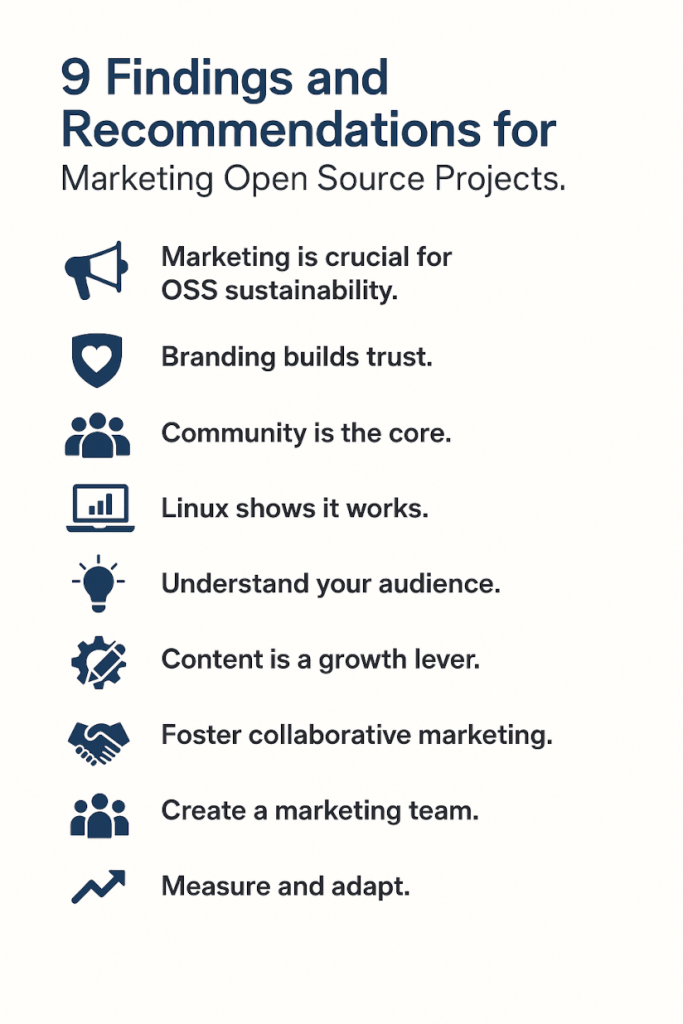As someone deeply passionate about open-source software, I’ve always believed in the power of collaboration. Through my research, I discovered that having great code isn’t always enough. With over 67 million open-source projects on GitHub alone, standing out requires more than just functionality—it requires communication, visibility, and a shared purpose. I found that OSS and Marketing Don’t Always Mix—But They Should.
However, how do you market something that’s free and built by volunteers? This 9-part blog series answers this by blending marketing theory with real-world OSS insights.
The Problem: Marketing in OSS Is Misunderstood
Despite their importance, marketing efforts in OSS projects often face:
- Apathy and resistance, especially from developers who see marketing as unnecessary or even harmful.
- Resource scarcity, including lack of time, funding, and marketing expertise.
- Fear of losing control, particularly when companies try to steer marketing without community consensus.
- Misconceptions, where marketing is equated with aggressive sales rather than brand building.
Key Insight: You’re Not Selling Software—You’re Selling the Vision
What really shifted my thinking was realizing that marketing in open source isn’t about commercializing the software. It’s about telling the story, attracting contributors, users, and sponsors. It involves helping others understand what the project is, why it matters, and how they can contribute.
Marketing, in this context, becomes a way to:
- Bring in new contributors and users.
- Recognize the hard work of current community members.
- Grow sustainably without compromising our values.
- Encourage project adoption.
- Foster community growth.
9 Core Findings and Recommendations
The following image summarizes the essential lessons learned throughout the series. Each point reflects a principle that can help open-source projects grow without compromising their identity or values.

1. Marketing is crucial for OSS sustainability.
Just having great code isn’t enough. Projects need branding, visibility, and clear value communication to attract and retain contributors and users.
2. Branding builds trust.
A strong, consistent identity helps users and developers connect emotionally with the project—essential for long-term engagement.
3. Community is the core.
Successful OSS marketing focuses on empowering and growing the contributor base through transparency, documentation, and inclusion.
4. Linux shows it works.
The success of Linux is a textbook example of OSS branding and community synergy, enhanced by strategic corporate partnerships.
5. Understand your audience.
Survey results show contributors are motivated by learning, collaboration, and purpose—not just tech. Speak to these drivers.
6. Content is a growth lever.
Great documentation, tutorials, community stories, and blogs drive visibility and user adoption.
7. Foster collaborative marketing.
Co-marketing with community members and contributors (e.g., case studies, events, webinars) amplifies reach and credibility.
8. Create a marketing team.
Successful projects like WordPress and Fedora dedicate volunteers or staff to marketing. You should too.
9. Measure and adapt.
Like any good campaign, OSS marketing should be iterative—test what works, listen to the community, and evolve.
My Recommendations for OSS Communities
If you’re involved in a community-driven OSS project, here’s what I believe can make a real difference:
- Be clear about the purpose of marketing. Communicate that we’re not “selling out” but rather building visibility and encouraging participation.
- Set clear goals and a mission. Whether we want more users, contributors, or sponsors, we need a shared direction.
- Create a community-led marketing team. A small group dedicated to communication can go a long way—especially when decisions are made transparently and collaboratively.
- Use the talents within the community. If someone in the community is good at speaking, writing, or design—give them a platform. Many of us already advocate for our projects on social media, at conferences, or in blog posts—we just don’t call it marketing.
- Collaborate with companies that give back. Co-marketing with “Makers” (not “Takers”) can be powerful—just keep transparency front and center.
- Prioritize transparency always. If the community feels left out, we risk losing our biggest asset. Open discussions and shared decision-making are essential.
- Celebrate all contributions. Code is critical, but so is storytelling, advocacy, and documentation. Let’s value it all.
Final Reflection: The Community Is the Brand
The biggest insight I took away from this journey is that the community isn’t just part of the project—it is the project. And marketing, when done with honesty and care, doesn’t threaten that. It strengthens it.
We don’t need to imitate corporate marketing. We need to define our own version—one that reflects our values of openness, trust, and collaboration.
“Open-source already won the battle against proprietary software. Now it’s time to win hearts—by telling our story and growing our brand the open-source way.”
This post is a summary of the final findings and conclusions from my blog series “Marketing an Open-Source Project,” where I explored how community-driven OSS projects can build brand awareness without losing their soul. The full series dives into marketing theory, case studies (like Linux), survey insights, and real-world examples from successful OSS communities. If you’re interested in the full journey—including sources and deeper analysis—you can find all the articles here.

I am a systems engineer with a great passion for open source, software development, and technology in general. I have been part of the iDempiere community since 2012. I believe the enterprise world is one of the most aggressive environments out there. Companies tend to ruthlessly compete against each other. That is why seeing competitors co-exist and cooperate in harmony in iDempiere (and OSS communities in general) is so interesting to me.
